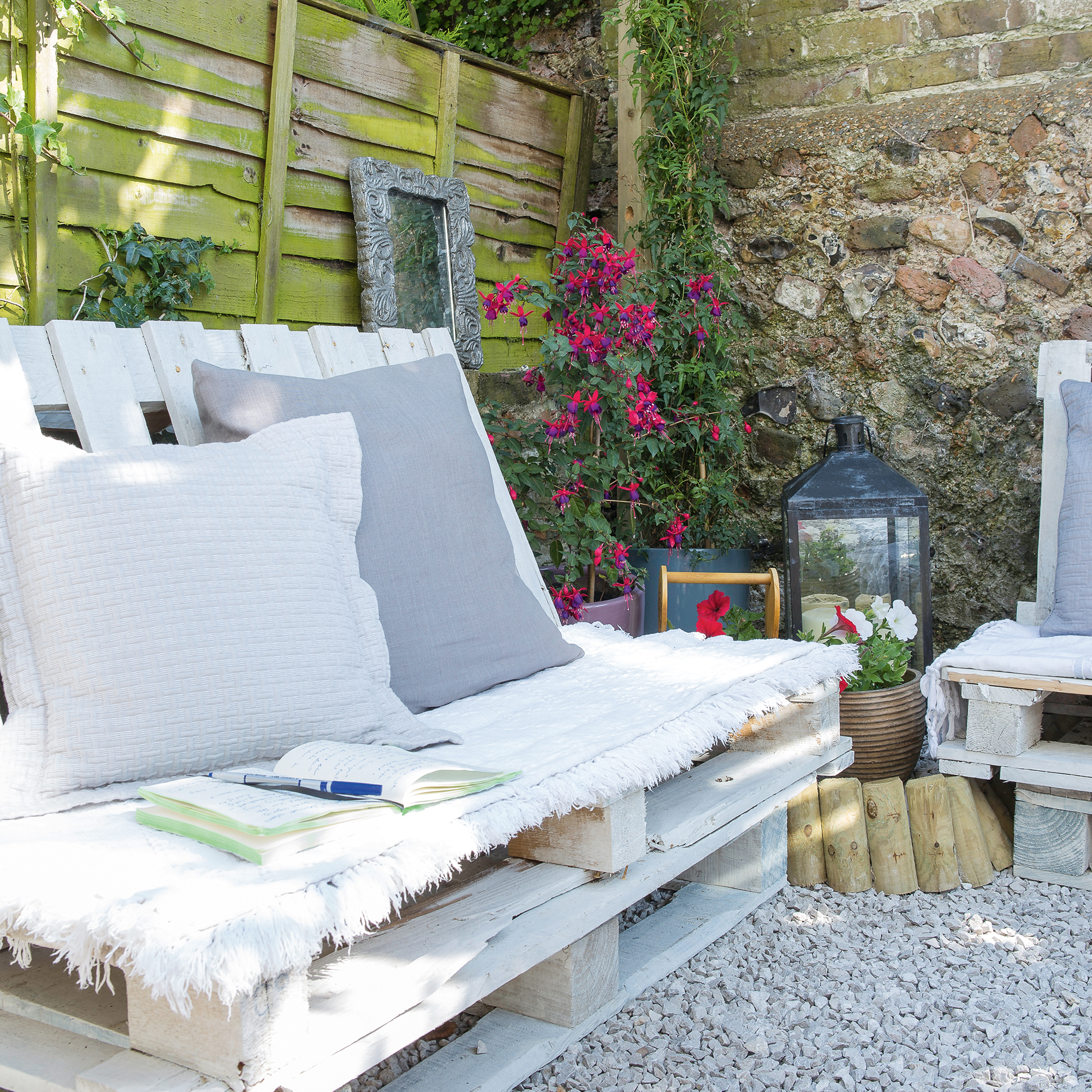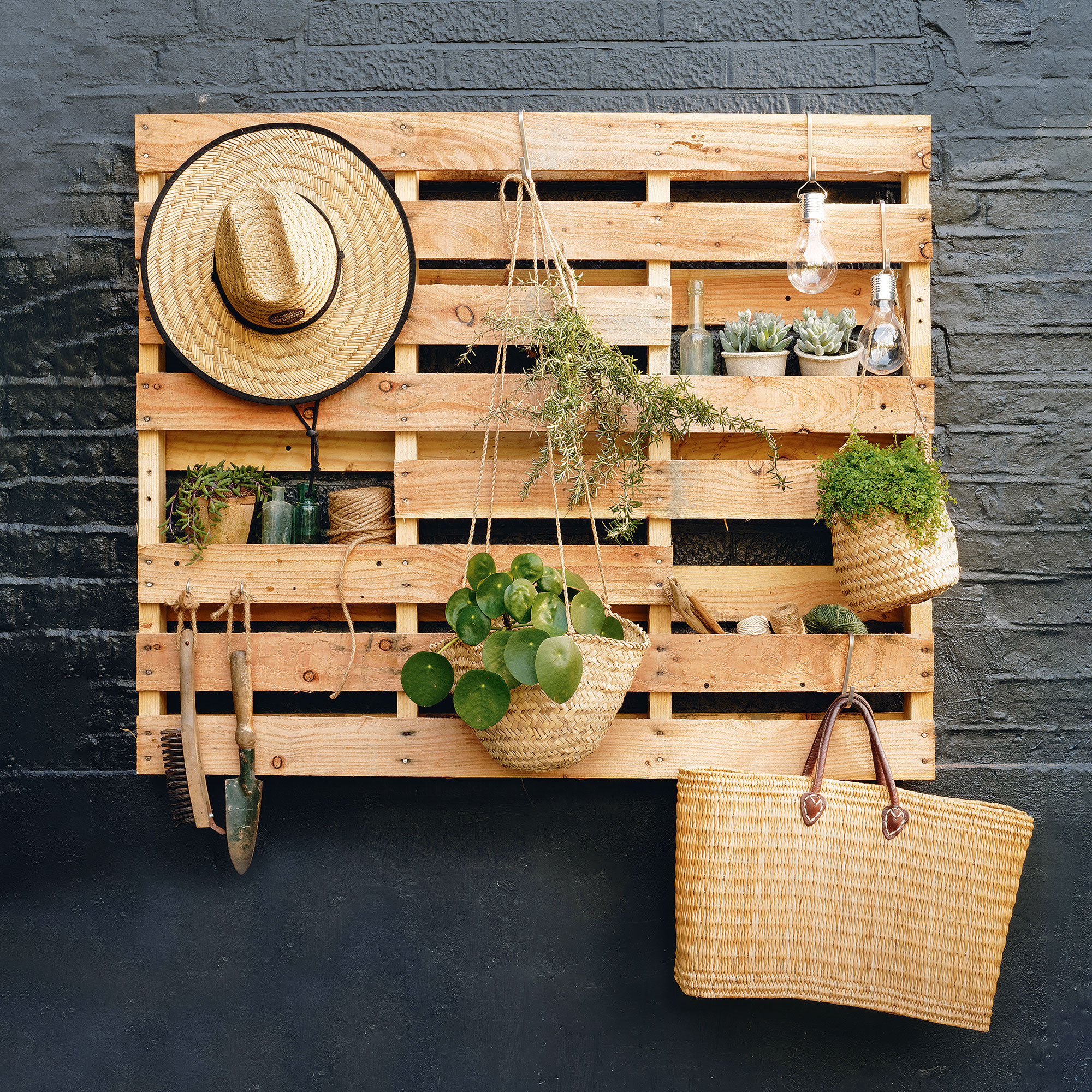7 things you need to know before making pallet garden furniture to save you time and money
Why buy off-the-shelf when you can make your own bespoke garden furniture?


If you’ve been scouring the internet for new tables and chairs for your garden, we have a question for you: Why don’t you make your own pallet furniture? You’re probably intrigued, but before you get too ahead of yourself, there are some things you should know before making pallet garden furniture.
While it’s easy to find the best garden furniture online and in-store, there’s nothing quite like making bespoke garden furniture to suit your style, your needs, and, most importantly, your space. And while there are so many pallet ideas for gardens out there, understanding the do’s and don’ts of making your own pallet furniture is key.
That’s why we’ve asked garden furniture experts, and those who have made their own pallet garden furniture, to share what they believe to be the most important things everyone should know before making their own pallet garden furniture. And if you abide by these tips, you’ll save both time and money.
7 things to know before making pallet garden furniture
‘Using pallets and repurposing them into furniture pieces is pretty common at the moment, not only because it seems to be trending but also because it's been discovered as a cheap alternative to buying expensive furniture. However, as pallets aren't exactly designed to be used as furniture, there are a few things you need to be wary of before you start turning any pallets into furnishings,’ explains Steve Chilton, garden expert at LeisureBench.
1. Always inspect the pallets first

Making your own pallet furniture is one of the best budget garden ideas out there. That’s because you can often pick up the main components (the pallets) for free.
That’s exactly what Vanessa Price, from @vanessa_inthe_cotswolds, did. She told us, ‘We chose to build pallet furniture as we like the rustic look of it over new wood and anything we could buy. If you can get the pallets free it makes it even cheaper for furniture that lasts for many years. We got our pallets free from free sites on Facebook and local websites.’
And while you can easily do the same, it’s important to make sure the pallets are in good shape before you take them home with you. Steve explains, ‘Always inspect the pallets for damage, and choose the best-looking pallets. Pallets with wood rot, mould, signs of wear and tear etc, are not suitable to be turned into furniture.’
Sign up to our newsletter for style inspiration, real homes, project and garden advice and shopping know-how
Because of this, it might take you a little while to search for the perfect pallets, but it’ll be worth it in the end.
2. Dismantling pallets requires special tools

Although you can fashion your own outdoor seating area or coffee table from full, intact pallets, dismantling them first allows for more flexibility in your design. However, this is easier said than done.
‘It’s surprising how much you actually have to dismantle the pallets before building the furniture,’ says Vanessa. ‘You can buy a special tool that removes the nails from the pallets, and this saves a lot of time and effort, so worth the investment.’
This is something that award-winning artist and content creator Theresa Gromski also discovered when she made her incredible outdoor pallet coffee table. She told us, ‘To get the pallet dismantled, use a special tool called a pallet breaker or lifting bar. You can also use a claw hammer. You’ll also need to remove any nails using either pliers or a claw hammer.’
You can pick up this Roughneck Angled Roofing Demolition & Lifting Bar from Amazon for less than £25, and if you don't already have a claw hammer at home, this isn’t too expensive either. In fact, this Claw Hammer from B&Q is just £4.99.
3. You’ll need to sand the wood
Unless you’re actively looking for that rough-and-ready look (with a few splinters thrown in for good measure), you’ll probably need to sand the wood of your pallets before making your pallet garden furniture.
Steve explains, ‘Naturally, pallets are rough and sharp in places, meaning you're going to have to do a lot of sanding to make sure the pallets are good for furniture use. Garden furniture that you buy ready-made is sanded so that it's smooth to the touch and won't cause injury, so it's important that you do the same when making your own furniture.’
‘An industrial sander is a great option, but hand-sanding is also possible (despite this probably taking quite a bit of time). You can choose to have your pallet furniture un-sanded, but just be aware that this could make it dangerous.’
Because of this, we’d suggest using something like this Black + Decker Mouse Sander with 10 Accessories from Argos to make things as easy as possible.

4. It’s best to use screws instead of nails
The beauty of pallet furniture is that it’s incredibly versatile and completely bespoke to your outside space. But anyone who has ever made pallet garden furniture will tell you that the finished product can be incredibly heavy, which can make moving it around incredibly difficult.
That’s why Vanessa suggests using screws instead of nails when making your pallet furniture. She says, ‘It’s a good idea to use screws, not nails, because of ease to take it apart if needed, and we have needed to several times, as it is too big and heavy to move in one piece.’
So, make sure you stock up on some nails before you put on your DIY hat.

5. Paint the pallets before assembling
If you were to search for some of the best wooden garden furniture, there’s a high chance that you’ll come across pieces that are primarily brown in colour. If you make your own pallet furniture, however, you can paint your garden furniture any colour you want, and even add painted patterns into the mix.
If you plan to do this, you should always try to paint the pallets before assembling if you can. This is something that Vanessa didn’t do the first time around.
‘The biggest piece of advice is to paint the pallets first before you put it together (that’s if you are painting it),’ she says. ‘Once it is built it is difficult to get to all the slats to paint. We made this mistake and built it all together first, and then we had to take it apart to get to parts of it.’
Of course, you also need to make sure that you’re using the right kind of paint for the job and give yourself enough time to complete this job (ideally, on a sunny day when there’s no chance of rain).
Vanessa said, ‘We used an outdoor wood paint like Cuprinol Shades. It has lasted four years. Choose your colour carefully, as I wouldn’t want to do it again anytime soon. Painting it was the most time-consuming part, as it takes several coats and is very fiddly.’
6. You’ll need to seal it

Unless you plan on covering your homemade pallet furniture with outdoor furniture covers when you’re not using it, you’ll definitely need to seal it.
Steve explains, ‘If you're having your pallet as a table or seating arrangement outside, then you'll need to protect the wood with a stain or varnish in order to protect it from the elements of the outdoors. It's important not to forget this step, otherwise, you'll find that your pallets don't last as long as they should.’
Thankfully, there are a few different options when it comes to sealant, as Theresa adds. ‘Depending on the look you want you can leave it natural, wax it, use a clear varnish or wax or stain or paint it. I’ve done all of these.’
When making her outdoor coffee table, Theresa used a clear varnish to protect it and give it an extra shine. If you want to do the same, you can use something like this Ronseal Yacht Varnish Clear Gloss from B&Q.
7. The opportunities are endless
Sure, it may be easier to buy off-the-shelf garden furniture - but making your own pallet furniture will save you money and allow you to create something bespoke for your garden.
The opportunities are endless when it comes to pallet furniture, as you can choose the design and the size of the furniture to suit your space and your needs. For example, you could make an outdoor table to match store-bought chairs you already have sitting in the shed, or you could go all out and make your own pallet tables and chairs from scratch.
You don’t have to stop there, though. You could also make your own DIY pallet bar or sun loungers if you really wanted. This is one of the reasons why Theresa loves making pallet garden furniture.
She says, ‘Besides my table, we also used pallet wood to make a herb wall planter and made a bath panel when we redid our bathroom.’

FAQs
Is it safe to make furniture out of pallets?
Yes! It’s perfectly safe to make furniture out of pallets as long as you take precautions and follow certain DIY rules.
For example, you should always inspect pallets before turning them into furniture. If the pallets show any signs of mould, rot, or general wear and tear, you shouldn’t use them to make furniture as they may be dangerous and fall apart.
As pallet wood is normally extremely rough, it’s also a good idea to sand pallets before turning them into furniture. This will prevent splinters and result in a smooth surface similar to that of store-bought garden furniture.
Is pallet furniture a good idea?
If you’re looking for a budget-friendly way to add garden furniture to your garden, pallet furniture is a fantastic idea. After all, you can normally pick up pallets for free on Facebook or from local businesses.
As if that wasn’t enough, pallet furniture also offers you the chance to make bespoke pieces for your outside space. This is great for those who have small or unusually-shaped gardens, as you can make furniture that fits your space.
Plus, you can go as simple or as wild as you like!
So, will you be making your own garden furniture?

Lauren Bradbury has been the Content Editor for the House Manual section since January 2025 but worked with the team as a freelancer for a year and a half before that. She graduated with a Bachelor’s degree in English and Creative Writing from the University of Chichester in 2016. Then, she dipped her toe into the world of content writing, primarily focusing on home content. After years of agency work, she decided to take the plunge and become a full-time freelancer for online publications, including Real Homes and Ideal Home, before taking on this permanent role. Now, she spends her days searching for the best decluttering and cleaning hacks and creating handy how-to guides for homeowners and renters alike, as well as testing vacuums as part of her role as the Ideal Home Certified Expert in Training on Vacuums, having spent over 110 hours testing different vacuum models to date!